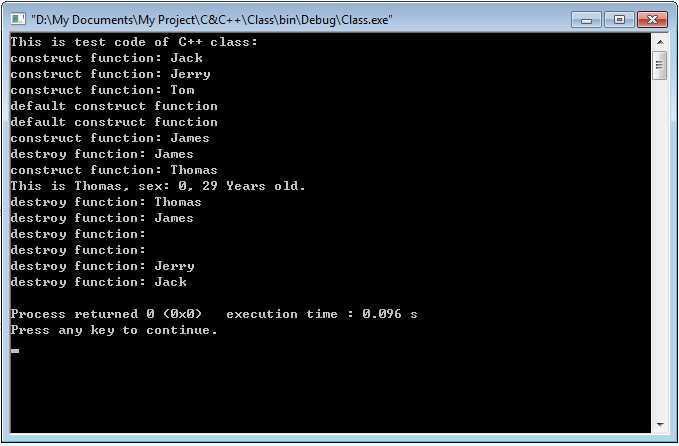标签:des style blog http color 使用 os io
本测试代码包括以下内容:
(1)如何使用构造函数;
(2)默认构造函数;
(3)对象间赋值;
(4)const使用语法;
(5)定义类常量: 一种方法是用enum,另一种方法是使用static。
#include <iostream> using namespace std; enum sexType { MAN, WOMAN }; class Human { //the default is private private: string name; sexType sex; int age; //(5) 定义类常量: 一种方法是用enum,另一种方法是使用static enum{LEN=1}; static const int LEN2 = 3; public: //如果类定义中没有提供任何构造函数,则编译器提供默认构造函数。但,如果类中定义了构造函数,那么编写者必须同时提供一个默认构造函数。 //有两种方法提供默认构造函数: //(1) 定义一个没有参数的构造函数:Human(); //(2) 为非默认构造函数的参数提供默认值: Human(string m_name="no name", int m_age=0, sexType m_sex=MAN); //两种定义方式只能二选一 Human(); Human(string m_name, int m_age, sexType m_sex); Human(int m_age); ~Human(); //定义在类声明中的方法为内联方法。也可以使用inline关键字将函数定义在类声明外部。 void show() const //const加在函数名后面表示该函数不会修改该类的数据成员。 { cout<<"This is "<<name<<", sex: "<<sex<<", "<<age<<" Years old."<<endl; } }; Human::Human() { cout<<"default construct function"<<endl; } Human::Human(string m_name, int m_age, sexType m_sex) { cout<<"construct function: "<<m_name<<endl; name = m_name; age = m_age; sex = m_sex; } Human::Human(int m_age) { age = m_age; } Human::~Human() { cout<<"destroy function: "<<name<<endl; } int main() { cout << "This is test code of C++ class: "<< endl; { //(1) use of construct function Human jack = Human("Jack", 30, MAN); //显示调用 Human jerry("Jerry", 26, MAN); //隐式调用 Human *pTom = new Human("Tom", 10, MAN); //New调用 //当构造函数只有一个参数时,可以直接用赋值语句赋值。只有一个参数的构造函数将会被自动调用 Human marry = 11; //赋值调用 //(2) defaults construct function Human Lucy; //(3) 赋值对象 Human James; James = Human("James", 28, MAN); //创建一个临时对象James,copy一份儿该对象赋值给James变量。紧接着该临时对象会被销毁。 //(4) const const Human Thomas("Thomas", 29, MAN); Thomas.show(); //The show method must define with ‘const‘ } return 0; }
运行结果为:

标签:des style blog http color 使用 os io
原文地址:http://www.cnblogs.com/Jerryli/p/3915358.html